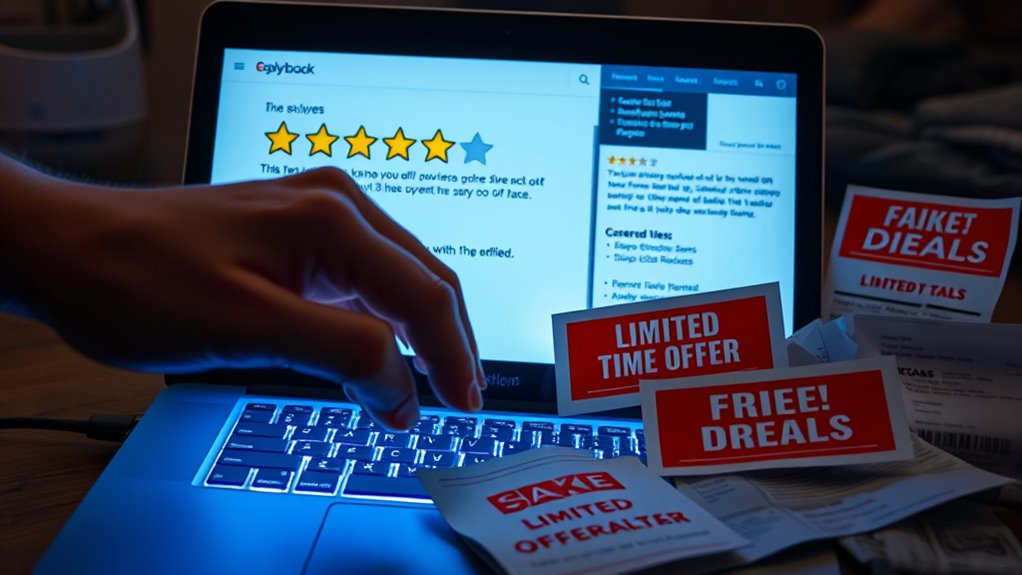To spot fake reviews and phony deals online, look for overly generic or overly positive language that sounds suspicious. Check reviewer profiles for new or limited activity, and see if multiple reviews follow similar patterns or phrases. Be cautious of deals that seem too good to be true, especially if details are vague or only found on questionable sites. Staying alert to language cues and profile behaviors helps protect you—continue exploring to learn more.
Key Takeaways
- Look for reviews with generic language, repetitive phrases, and overly positive or emotional wording.
- Check reviewer profiles for limited activity, recent creation dates, and minimal personal information.
- Be skeptical of deals that offer unrealistically low prices or excessive discounts without credible sources.
- Cross-verify suspicious deals on official websites or trusted platforms for legitimacy.
- Identify patterns of fake reviews by noting similar wording, lack of detailed experiences, and profiles with suspicious activity.

In today’s digital marketplace, fake reviews and phony deals have become common tricks used to deceive consumers. As you browse online, it’s crucial to develop skills in trustworthiness analysis to separate genuine offers from scams. Scammers often craft convincing reviews to boost their products or services, making it harder for you to distinguish authentic feedback from fabricated praise. Using effective scam detection techniques can help you identify these false signals before falling prey to deceptive schemes.
One of the first steps in spotting fake reviews is to examine the review patterns. Look for reviews that sound overly generic or overly positive without specific details. If multiple reviews on a product or service read like carbon copies—repeating similar phrases or mentioning the same unrealistic benefits—you should be skeptical. Authentic reviews tend to be more varied and include both pros and cons, reflecting genuine user experiences.
Fake reviews often mimic each other, lacking specific details and sounding overly positive or generic.
Another way to enhance your scam detection techniques involves analyzing reviewer profiles. Fake reviews often come from accounts with limited activity, recent creation dates, or profiles lacking personalized information. Conversely, legitimate reviewers tend to have a history of diverse reviews across different products and a consistent online presence. Be wary of reviews from accounts that only review one product or service, especially if those reviews are posted in quick succession or all within a short time frame.
Pay close attention to the language used in reviews and deals. Scammers frequently use exaggerated claims, urgent language, and emotional appeals to push you into quick decisions. Phrases like “must buy now,” “limited time only,” or “guaranteed to work” are red flags. Authentic deals and reviews, however, tend to be more balanced and transparent, highlighting potential drawbacks or limitations. Trustworthiness analysis involves recognizing these linguistic cues that signal deception.
Additionally, verify the consistency of the deal details. Phony deals often feature suspiciously low prices or unrealistic discounts that seem too good to be true. Cross-check these deals with other reputable sources or official websites to confirm their legitimacy. If the deal appears only on questionable sites or lacks detailed terms and conditions, it’s likely a scam. Understanding credible sources and the typical fees associated with investment products like Gold IRA can also help identify legitimate offers from fraudulent ones.
Frequently Asked Questions
How Can I Verify the Authenticity of Online Reviews?
To verify the authenticity of online reviews, look for review verification badges or indicators that show the review is genuine. Pay attention to authenticity indicators like detailed, specific comments and balanced ratings. Check reviewer profiles for activity and consistency. Be cautious of overly positive or negative reviews that seem generic. Cross-reference reviews across multiple sites and use third-party tools to assess review credibility, ensuring you make informed decisions based on trustworthy feedback.
What Are Common Signs of a Fake Deal?
A fake deal often seems too good to be true, signaling review manipulation or scam tactics. Watch for deals with overly enthusiastic language, limited or no details, and suspiciously high discounts. If the deal’s inconsistent across platforms or if the seller pressures you to act fast, it’s a warning sign. These signs help you recognize fake deals and avoid falling for scams that prey on your trust.
Are There Tools to Detect Fake Reviews Automatically?
Yes, there are tools that automatically detect fake reviews using review analysis and sentiment detection. These tools analyze patterns, language, and review timing to identify suspicious activity. You can use platforms like Fakespot or ReviewMeta, which scan reviews, assess authenticity, and flag potential fakes. By leveraging these tools, you can make better-informed decisions online and avoid falling for deceptive reviews or fake deals.
How Do Fake Reviews Impact Consumer Trust?
Like a knight in shining armor, genuine reviews once built trust, but review manipulation now threatens it. Fake reviews cause trust erosion because you can’t rely on what’s real anymore. When you encounter suspicious feedback, your confidence in the product diminishes, making you hesitant to make purchases. This erosion not only impacts your trust but also harms honest sellers who depend on authentic feedback to grow and succeed.
What Should I Do if I Suspect a Review or Deal Is Fake?
If you suspect review manipulation or a scam, stop and don’t proceed. Research the product or deal across multiple trusted sources, checking for consistency. Look for suspiciously positive reviews or overly generic comments, and trust your instincts. Report the suspicious activity to the platform to help with scam prevention. Staying cautious and verifying details helps protect you from falling for fake reviews and phony deals.
Conclusion
To spot fake reviews and phony deals, stay vigilant and trust your instincts. Always do your research and look for patterns or inconsistencies. Remember, if something seems too good to be true, it probably is. Don’t let your guard down, or you might get caught in the web of deception. Keep your eyes open and stay informed—because when it comes to online deals, it’s better to be safe than sorry.








